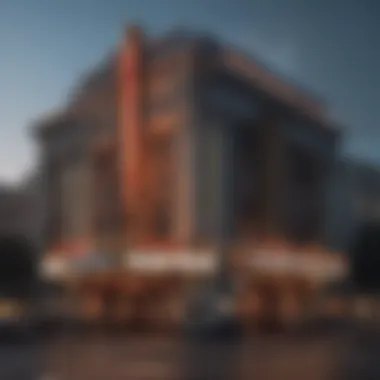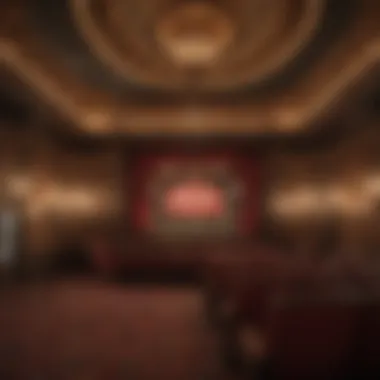The Tower Theater: A Historic Cinematic Icon in LA


Intro
The Tower Theater in Los Angeles is not just another building; it is a testament to the city’s cinematic heritage and architectural evolution. Established in the 1920s, this landmark has witnessed significant cultural moments and transformations in Hollywood's film industry. Its design reflects an era where cinema was seen as a luxurious experience, merging intricate architectural elements with the excitement of silent film and talkies.
This article examines the Tower Theater's architectural importance, its cultural significance, and the efforts made towards its restoration and future integration into the entertainment landscape. By exploring various aspects of this iconic venue, we can appreciate its continuous role as a center for creativity and artistic expression in Los Angeles.
Historical Background
The Tower Theater opened its doors in 1927 and quickly became a hub for cinema lovers. Nestled in downtown Los Angeles, it was one of the first theaters in the city to feature a fully equipped atmospheric setting, designed to evoke the feeling of being outside under a starl-lit sky. This unique concept revolutionized the viewing experience.
Over the decades, the theater transitioned to show various films, accommodating changing tastes among audiences. Its significance is not only tied to cinematic history but also highlights the architectural trends of its time, marking the late 1920s as a golden age for theaters in the United States.
Architectural Significance
Design Elements
The Tower Theater showcases a distinct blend of Spanish and Art Deco design. The exterior is adorned with intricate tile work and bold geometric patterns, a characteristic element of the era's architecture. Its marquee, with neon lights, creates a striking appearance, drawing attention to the entrance.
Inside, the theater boasts a lavish auditorium, complete with detailed plasterwork and rich color palettes that enhance the overall ambiance. The stage was built with acoustics in mind, contributing to a superior audio experience for live performances.
Restoration Efforts
Restoration of the Tower Theater has been vital for preserving its historical integrity. In recent years, initiatives have focused on refurbishing both the exterior and the interior. This includes repairing damaged architectural elements and upgrading facilities to meet contemporary standards while maintaining its historical charm.
Cultural Impact
The cultural significance of the Tower Theater extends beyond its architectural beauty. It has served as a venue for numerous film premieres, cultural events, and educational programs. This engagement fosters community involvement and positions the theater as a vital part of Los Angeles' creative ecosystem.
"The Tower Theater remains a pivotal space reflecting the heart and soul of Los Angeles cinema."
The theater's ability to adapt has allowed it to anchor various cultural movements, becoming a place where art and engagement intersect.
Contemporary Relevance
Today, the Tower Theater stands at a crossroads, balancing tradition and modernity. Its restoration efforts are aimed not only at gaze backward but also at envisioning its future role in the city's entertainment landscape. Plans include integrating contemporary technology and event programming that may attract diverse audiences while honoring its rich legacy.
Historical Overview of Tower Theater
The Tower Theater in Los Angeles serves as a vital piece of cinematic history. Understanding its historical context provides valuable insights into its architectural and cultural significance. Built in a time when cinema was becoming an essential part of American life, the Tower Theater reflects both the architectural trends and societal values of the era. Its evolution mirrors broader shifts in film and entertainment.
Construction and Early Years
The Tower Theater, located at 802 South Broadway, was constructed in 1927. Designed by the notable architect S. Charles Lee, this venue was a testament to the lavish movie palaces of the time. It was originally planned as a venue for silent films, embodying the grand style that attracted audiences. The building's striking exterior featured distinctive terracotta tiles and an iconic tower, which made it stand out on Broadway.
In its early years, the Tower Theater became a hub for film premieres and special screenings. It reflected the optimism of the Roaring Twenties, showcasing the latest trends in film and attracting star-studded audiences. With a seating capacity of over 1,000, it was not just a place for viewing films but a social scene for Los Angeles’ affluent community.
Cinematic Milestones
Over the decades, the Tower Theater had a significant role in cinematic history. It hosted premieres for major films, particularly during Hollywood's Golden Age. In the 1930s, it adapted to the advent of ‘talkies,’ embracing the new technology by outfitting the space for sound films.
Through the years, the theater has been a venue for artistic expression. It showcased films that were not only commercially successful but also culturally important. This includes classic films that shaped the very notion of cinematic art. The theater contributed to showcasing diverse stories in an era where this was not standard in mainstream cinema, thus playing a role in cultural exchanges.


Decline and Closure
By the late 20th century, the Tower Theater faced challenges. The rise of multiplex cinemas diminished its appeal. Changes in entertainment consumption, like video rentals and later streaming services, also impacted attendance. These shifts contributed to a decline in its operational viability. Despite its rich history, the theater ultimately closed its doors to the public in the early 2000s.
The closure marked a significant shift in the landscape of Los Angeles cinema. Many feared it would succumb to neglect and decay, representing a loss of cultural heritage. The theater's decline reflected broader trends in urban development, where historic venues often struggle to compete with modern entertainment options.
"The Tower Theater is more than just a building; it is a symbol of Hollywood's evolution and the changing landscape of American cinema."
The historical overview of the Tower Theater sets the groundwork for understanding its architectural features, cultural impact, and future prospects. Acknowledging its past helps in appreciating its significance as one of Los Angeles’ historic landmarks.
Architectural Features
The Tower Theater in Los Angeles stands not only as a significant cinematic venue but also as a prime example of architectural prowess. Its architectural features enhance its cultural standing and reflect the evolution of design aesthetics in the context of urban cinema. Particularly for architects, historians, and enthusiasts, the elements within the theater offer valuable insights into early 20th-century design philosophies and cultural trends.
Design Aesthetics
The design aesthetics of the Tower Theater is a blend of various architectural styles. When designed, it embodied the elements of the Renaissance Revival style, which was prominent in the 1920s. The facade of the building is intricately decorated, showcasing terra cotta details and a grand marquee that served to attract moviegoers.
The marquee, in particular, remains a focal point, displaying film titles in bright lights and captivating the attention of those passing by. Windows are strategically placed, allowing natural light to enhance the interior while maintaining an air of sophistication. These aesthetic choices not only drew patrons but also solidified the Tower Theater's status as an essential hub for cinematic experience.
Interior Layout
The interior layout of Tower Theater is carefully crafted to provide an engaging viewing experience. Upon entering, patrons encounter a spacious lobby adorned with ornate finishes that reflect the opulence of the era. The design of the seating area is arranged to maximize visibility of the screen, ensuring that each viewer has an unobstructed view.
The placement of aisles is deliberate, allowing for smooth transitions and minimizing disruption during showings. The acoustics within the auditorium have also been meticulously considered. This attention to layout enhances its functionality and serves the audience’s needs, encapsulating a full cinematic experience.
Renovations and Historical Preservation
Over the decades, renovations of Tower Theater have been necessary to maintain its structural integrity while preserving its historical significance. Developers aimed to balance modern needs with the preservation of original elements. For example, the restoration process included updating the projection equipment without compromising the aesthetic aspects of the space.
Current owners have invested in renovations that respect the original design while integrating modern technology. The preservation of the building's historical aspects is crucial, as it maintains the cultural narrative tied to the film industry.
"The Tower Theater stands as a reminder of Los Angeles' cinematic heritage, merging architectural beauty with historical value."
The practices of restoration often face challenges, especially when addressing changes in safety regulations and modern audience expectations. Nevertheless, the ongoing efforts to uphold the architectural features of the Tower Theater showcase a commitment to both heritage and innovation.
In summary, Tower Theater's architectural features are not merely about the looks; they play a vital role in understanding its significance within the larger context of Los Angeles' cultural landscape. The design aesthetics, interior layout, and thoughtful renovations provide a layered narrative that highlights this landmark as more than just a venue for films but as a crucial part of the community's architectural heritage.
Cultural Significance
Understanding the cultural significance of the Tower Theater in Los Angeles involves considering its multifaceted role in the local and broader cinematic landscape. This venue is not merely a relic of the past; it embodies the essence of cinema's evolution, making it a site of critical importance for both historical preservation and contemporary discourse. The Tower Theater illustrates how architecture and film intertwine, serving as a focal point for community engagement and artistic expression.
Role in the Film Industry
The Tower Theater has long been a landmark in the film industry. Originally opened in 1927, it played a vital role in introducing the movie-going experience to countless Angelenos. With its striking design, the theater quickly became a popular venue for premieres and special screenings of significant films. This location contributed to the burgeoning film culture of Los Angeles, cementing its status as the heart of the entertainment industry.
Over the decades, the Tower Theater has hosted a variety of notable films, drawing audiences eager to engage with both classic and contemporary productions. This legacy continues as the theater evolves, adapting to new cinematic trends while still honoring its rich heritage. The historical significance of this venue is reflected not only in the films shown but in how it remains a stage for dialogue about the art of filmmaking itself.
Community Engagement
The Tower Theater is central to community engagement in Los Angeles. It offers a space where residents can come together to experience film in ways that resonate with local culture. Events such as film festivals or community screenings create a vibrant platform for dialogue and interaction among diverse audiences. Moreover, the theater often collaborates with local organizations and artists, providing essential resources for emerging talent.
These partnerships reflect a commitment to fostering local creativity and inclusiveness. Such engagement demonstrates how this historic venue serves as a community hub, encouraging participation in the arts and reinforcing the value of public spaces in urban life.


Artistic Contributions
Artistic contributions from the Tower Theater extend beyond films. The venue has often served as a backdrop for various art installations, performances, and special events that reflect the evolving nature of artistic expression. Its interior design can inspire new artistic endeavors, as many creatives see the theater as a blank canvas that can be transformed into an immersive environment for storytelling.
Furthermore, the preservation efforts surrounding the Tower Theater have also inspired discussions about artistic heritage and identity. This commitment inspires both traditional and innovative forms of art. By remaining relevant in the changing landscape of the arts, the Tower Theater demonstrates its capacity to adapt while retaining its historical essence.
"The Tower Theater is not just a place to watch movies; it is a symbol of cultural richness and an opportunity for artistic collaboration."
In summary, the Tower Theater's cultural significance is multifaceted. Its contributions to the film industry, role in community engagement, and its artistic collaborations showcase how this venue maintains its importance. As it continues to evolve, the Tower Theater remains a beacon of culture in the heart of Los Angeles.
Contemporary Usage
In the current landscape of Los Angeles, the Tower Theater has adapted to remain a key player in the cultural scene. Its significance goes beyond nostalgia; it exemplifies how historical venues can evolve to meet contemporary needs and interests. This section explores the various aspects of the Tower Theater’s contemporary usage, focusing on ongoing management practices, event programming, and technological advancements.
Current Ownership and Management
The management of Tower Theater has shifted over the years, impacting its operational strategies and goals. Currently, the building is owned by a group that is committed to preserving the theater's historical integrity while ensuring its relevance in today’s entertainment environment. This type of ownership allows for a blend of historical respect and modern practicality.
The management team emphasizes a unique approach to maintain the character of the venue while enhancing visitor experience. They strive to bring a variety of productions, theater shows, and events that appeal to a diverse audience. This ownership model not only preserves the building but also fosters community ties by encouraging local artists and organizations to use the space.
Programming and Events
Event programming at the Tower Theater plays a crucial role in its contemporary usage. The venue accommodates a wide range of activities including film screenings, live music performances, and theatrical productions. Such a varied offering reflects the theater's cultural significance, acting as a hub for both established and emerging talents.
- Regular Film Screenings: The theater showcases classic films and contemporary indie productions, allowing audiences to experience cinema in a historical setting.
- Live Performances: Local musicians and theater companies are frequently hosted, providing a platform for community engagement.
- Special Events: The venue also organizes film festivals and themed nights, creating opportunities for niche audiences to come together and celebrate their interests.
This range of programming not only attracts a diverse audience but also turns the Tower Theater into a lively space for artistic expression. It reflects its ability to fuse the past with the present, creating an engaging atmosphere.
Technological Innovations
The integration of new technologies in the Tower Theater has helped redefine its place in the modern entertainment sector. The management has invested in high-quality audio and visual systems, which enhance the overall experience for attendees. This modernization is vital in attracting younger, tech-savvy audiences who expect a specific level of technological sophistication in venues.
- Digital Ticketing Systems: Adoption of online ticketing makes accessing events easier and more convenient.
- Advanced Projection Techniques: Upgraded projection systems facilitate high-definition screenings, ensuring that films are presented in the best possible quality.
- Social Media Engagement: The use of platforms like Facebook and Reddit for promotion creates a dynamic interaction between the theater and its audience, fostering community spirit.
By embracing these innovations, the Tower Theater not only safeguards its legacy but also positions itself as a modern venue capable of competing in a fast-evolving entertainment landscape.
"The Tower Theater represents more than just a historic site; it is a living entity that reflects the ongoing evolution of urban culture and entertainment."
Future Prospects
The future of Tower Theater holds substantial importance as it not only signifies the preservation of an iconic venue but also illuminates the evolving nature of urban cultural spaces. Understanding future prospects involves exploring potential developments, the economic impact on the local community, and the challenges surrounding legacy and preservation. Each aspect plays a crucial role in determining how the Tower Theater can adapt to new trends while maintaining its historical significance.
Potential Developments
As Los Angeles continually evolves, the Tower Theater is ripe for a variety of potential developments. One significant area of growth is the integration of digital technology into its programming. This could enhance viewing experiences, drawing in new audiences. Potential partnerships with streaming platforms or tech companies could lead to innovative content delivery or interactive events.
However, development should also embrace the historical essence of the theater. Balancing modern amenities with preservation of original features is essential. Ideas could include hosting film festivals that showcase independent films or offering educational workshops about filmmaking. Creating a community-related space, which could double as a venue for local artists, enhances engagement.
Impact on Local Economy
The revitalization of the Tower Theater stands to significantly impact the local economy. By transforming the theater into a vibrant cultural hub, it can attract both locals and tourists. Increased foot traffic can benefit nearby businesses such as restaurants and shops, creating a positive economic ripple effect.


Moreover, job creation is another vital aspect. Employment opportunities can arise from diverse programming and the need for staff management, maintenance, and marketing. Events hosted at the theater could lead to increased tax revenues for the city, which in turn can be reinvested into the community, promoting further development.
Legacy and Preservation Challenges
Preserving the Tower Theater comes with numerous challenges that must be addressed to honor its legacy. Maintaining the architectural integrity while adapting to contemporary needs is complex. Fundraising and partnerships with preservation societies may be necessary to secure resources for necessary restorations or upgrades.
Moreover, there is a constant balancing act between commercial viability and historical preservation. Community backlash against potential commercialization could pose hurdles, as locals often prioritize the theater's cultural significance over profit. Findings from other historical restorations indicate the importance of aligning projects with community interests to achieve sustainable success.
"The preservation of cultural heritage is not merely a matter of nostalgia; it's an investment in community identity."
Comparative Analysis
The comparative analysis of the Tower Theater in Los Angeles sheds light on its unique position within the landscape of historic cinemas. By evaluating similar theaters across major cities, one can appreciate the cultural, architectural, and operational nuances that contribute to the significance of the Tower Theater. This analysis helps in understanding how historical venues adapt to modern demands, maintain their relevance, and continue to engage audiences. Furthermore, examining lessons learned from other restoration projects provides insights into the methodology and challenges inherent in preserving such landmarks.
Similar Theaters in Major Cities
Examining theaters like the Fox Theater in San Francisco or the Orpheum Theatre in New York reveals common themes and differences in maintaining historical significance while remaining viable in today’s entertainment landscape. The Fox Theater, with its ornate design and rich history, also struggled through periods of decline but has been rejuvenated as a cultural hub for music and film. Similarly, the Orpheum Theatre has preserved its historical character while adapting its programming to local needs, showcasing both live performance and film screenings.
These theaters exemplify how historic venues can thrive by understanding their communities and responding to contemporary audience preferences. Notably, both the Fox and Orpheum have embraced technological advancements in sound and projection, enhancing the viewer experience.
Lessons from Other Restorations
Restoration projects offer valuable lessons for the future of the Tower Theater. A significant example is the restoration of the Egyptian Theatre in Los Angeles. The efforts involved careful attention to original architectural details while upgrading facilities to meet current standards. This project was not just about preserving a building but also about ensuring it served a purpose within the community.
Key lessons from such restorations include:
- Community Involvement: Engaging local stakeholders often leads to a more successful outcome.
- Funding and Grants: Secure funding through grants or sponsorships to support preservation efforts.
- Modern Amenities: Balancing historic preservation with modern conveniences improves audience satisfaction.
The Egyptian Theatre’s success in melding these elements speaks to a broader strategy for the Tower Theater's future.
Impact of Modern Cinema on Historical Venues
Modern cinema continues to exert influence over historical venues like the Tower Theater. The rise of streaming services and mega-theaters has shifted audience expectations towards instant access and superior comfort. As a result, historical theaters often face pressure to adapt their programming and amenities.
Some impacts include:
- Programming Changes: Many venues now integrate diverse offerings, such as classic film nights alongside new releases.
- Technology Upgrades: Investments in high-definition projection, sound systems, and comfortable seating are critical for attracting modern audiences.
- Community Events: Hosting unique events can create a draw, as seen with themed screenings or interactive experiences.
Balancing historical integrity with modern trends is essential for sustaining relevance. While modern cinema changes the film landscape, it can also drive innovation in historical venues, fostering a unique blend of past and present.
The preservation of historical venues requires not only respect for their past but also a vision for their future.
Closure
The conclusion of this article encapsulates the layered significance of the Tower Theater in Los Angeles. As an emblem of cinematic history, this venue stands as a testament to the evolving landscape of both film and architecture. The Tower Theater is not just a building; it is a narrative woven into the fabric of Los Angeles, highlighting its cultural and historical milestones.
Summarizing Key Takeaways
Several key points emerge from the exploration of the Tower Theater. First, its historical trajectory showcases not only the architectural trends of its time but also the shifting cultural values and the audience's engagement with cinema. Additionally, the theater's current utilization emphasizes its adaptability in the face of modern technological advancements. This evolution ensures it remains relevant to contemporary audiences while preserving its stunning historical essence.
- The Tower Theater reflects significant cinematic milestones, offering insights into the film industry's progression.
- It has served various community needs through diverse programming and events.
- The ongoing renovations aim to harmonize modernity with historical preservation, enriching the local cultural scene.
The Future of Tower Theater
Looking forward, the future of the Tower Theater appears promising yet complex. Potential development projects can enhance its offerings and services, making it a hub for entertainment and community engagement. However, challenges remain, particularly in maintaining a balance between modernization and historical integrity.
Community input will be crucial in shaping the theater's evolution. The potential impact on the local economy is also significant, providing jobs and tourism attractions.
In sum, the Tower Theater embodies a bridge from the past to the future, ensuring that its legacy will continue to resonate in both cinematic and community contexts.



